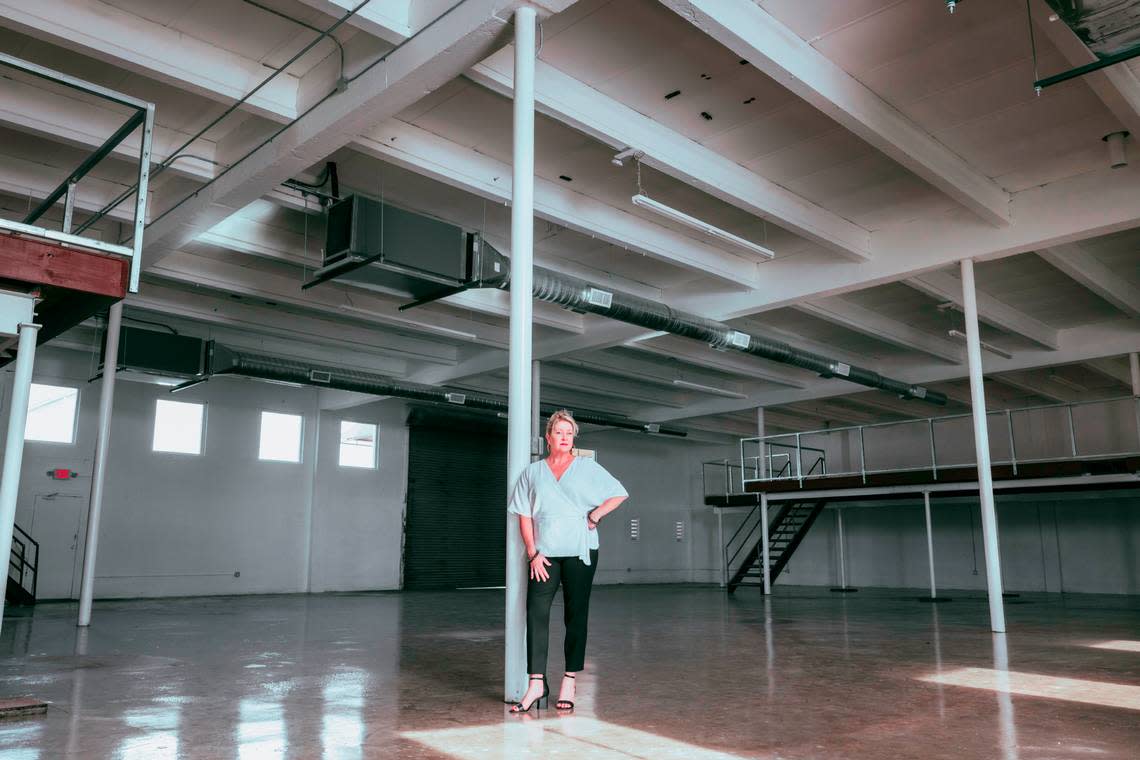‘A game changer.’ This Miami alternative arts nonprofit is moving to Little River
Locust Projects’ Design District location has seen it all in the past two decades: indoor pools with synchronized swimmers; dump trucks of soil; jackhammered floors; working kilns and a hanging garden.
Miami’s longest running alternative art space announced Wednesday that the organization will move into a warehouse space in Little River that’s double the size of its current location. The new building, at 297 NE 67th St., will open in February, just in time for the nonprofit’s 25th anniversary.
The local arts group will use the 8,000 square-foot, empty warehouse as a big blank canvas for artists to continue to (literally) do whatever they want.
“We were just really thrilled when we found this space,” said Locust Projects executive director Lorie Mertes. The bigger space will allow the group to expand their mission to serve both artists and audiences, she said.
Locust Projects is the latest arts group to announce its moving shop to Little River. Arts nonprofit Oolite Arts will open its new state-of-the-art headquarters in the neighborhood by 2024, less than a mile away from Locust Projects’ new space.
The nonprofit is a unique arts incubator and gallery space in Miami, offering pro bono legal services for artists and public programs. It was founded by artists for artists in 1998 as a space to feature ambitious and innovative works that commercial galleries and museums would never approve. The nonprofit promotes a “culture of yes” that seeks to support artists in their endeavors, even if that means taking a jack hammer to the floor or building an above-ground pool.
“Our spaces are not meant to be precious,” Mertes said. “We’re not a museum with pristine walls and floors.”

That makes a former warehouse the perfect fit. Locust Projects has simply outgrown its first home in the Design District, Mertes said.
The original location is in an old building with a history of termites, a leaky roof and dodgy air-conditioning. Another concern was the amount of space, or lack thereof, for people to experience the art in its full, alternative glory. Mertes recalled an event where people squeezed into the front lobby to watch musicians perform a duet on a joined violin. Of course, the AC died.
Though the location served them well, the lease was coming to an end, anyway, Mertes said. It was time for a change.
“Being able to really be a welcoming and functional space for artists to realize those projects as well as being a space for public gathering is going to be, for us, a game changer,” Mertes said.
The bright-white corner unit in Little River has nothing but space. The new building has an open floor plan, 17-foot-high ceilings and access to a large, enclosed outdoor courtyard to host events, art shows and performances.
Mertes said she is planning a series of get-togethers with the local artist community to discuss how the space can be built out and used in the future. The nonprofit is also planning a “housewarming” fundraiser where the public can get a sneak peek of the new space Nov. 12.
“There’s so much potential,” she added.
In the meantime, the Design District location is still open and free to the public. On Nov. 19, the space will open two exhibitions: “ule ole allez” by Ronny Quevedo and “Room for the living / Room for the dead” by T. Eliott Mansa.
The move was supported by a grant from philanthropist and Locust Projects board member Diane “Dede” Moss and a five-year $1 million grant from the John S. and James L. Knight Foundation.
“Locust Projects holds a unique place in South Florida’s arts ecosystem as a creative incubator supporting the production of experimental new work and introducing the community to the creative process,” said Victoria Rogers, the Knight Foundation vice president of arts. “We’re excited by Locust Projects’ ongoing evolution and how this new home will expand its ability to accelerate the careers, and increase access to the work of featured artists.”
Artist and Locust Projects board member Antonia Wright said the new space will benefit the careers of more emerging artists in Miami.
In 2016, after submitting an application to Locust Projects’ open call, Wright was able to bring “an idea living in my notebook” to life. She created “Under the water was sand, then rocks, miles of rocks, then fire,” a film and sight-specific installation with a floating maze of night blooming jasmine flowers.
Most museums have a “no no policy” when it comes to installing living plants, Wright said. But at Locust Projects, “you’re allowed to take risks” to fulfill your vision.
The unique exhibition had a positive impact on Wright’s career, she said. Now, she’s looking forward to Locust Projects reaching more artists and community members through its programming.
“It’s a special place,” she said.
This story was produced with financial support from The Pérez Family Foundation, in partnership with Journalism Funding Partners, as part of an independent journalism fellowship program. The Miami Herald maintains full editorial control of this work.
